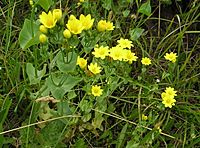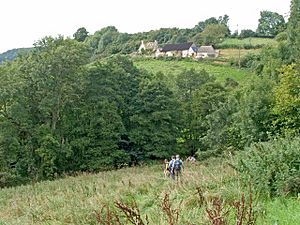Snows Farm Nature Reserve facts for kids
Snows Farm Nature Reserve is a special place in Gloucestershire, England, where nature is protected. It's about 21.3-hectare (53-acre) big, which is like 52 football fields! This area is so important for wildlife that it's officially known as a Key Wildlife Site.
The Gloucestershire Wildlife Trust takes care of Snows Farm. They started looking after it in 1975, and then in 1989, a kind person named Mr. P. Duddridge gave the land to the Trust.
Contents
Exploring Snows Farm Nature Reserve
Snows Farm is located at the top of the Slad Valley, about three miles north-east of Stroud. A small stream called the Dillay Brook flows right through the middle of the reserve. The land here is a mix of untouched grassy fields, woodlands, and areas with bushes and shrubs.
The reserve has two main slopes. One side faces south-east and has deeper, more neutral soil. The other side faces north-west and has thinner soil over limestone. This difference in soil helps many different kinds of plants grow here.
At the northern end of the reserve, you'll find an old, ruined building known as the Old Shop. All that's left is a stone wall and a pile of rocks. You can get to Snows Farm from a track that comes from the village of Slad. The reserve has fences, stiles, and gates, and sometimes sheep or cattle might be grazing there to help manage the land.
Amazing Wildflowers at Snows Farm
Snows Farm is famous for its many beautiful wildflowers.
Limestone Grassland Flowers
The areas with limestone soil are home to special orchids like the early purple orchid, fragrant orchid, and pyramidal orchid. You might also spot the autumn gentian, vervain, yellow-wort, and clustered bellflower. Look closely, and you might even see wild columbine, wild liquorice, adder's-tongue, stinking hellebore, and the small teasel.
Neutral Grassland and Stream Flowers
The grassy areas with more neutral soil have flowers like betony, lousewort, devil's-bit scabious, and lady's-mantle. Near the wetter stream, you'll find ramsons and golden-saxifrage. Marshy spots are perfect for forget-me-not, brooklime, and marsh-marigold. You can also see ferns like the hart's-tongue.
Woodland Flowers
In the woodland at the top of the west slope, look for moschatel, spurge-laurel, and wood anemone. An uncommon plant called fingered sedge (Carex digitata) also grows here. In total, over 300 different types of plants have been found at Snows Farm!
Trees and Bushes of the Reserve
The scrub areas are filled with bushes like dog-rose, field-rose, hawthorn, dogwood, and wayfaring-trees. Along the stream, you'll see trees such as alder, white willow, ash, and hazel.
At the top of the west slope, there's a woodland with beech and ash trees. In this area, you can also find field maple, hazel, and wild cherry.
Bird Life at Snows Farm
Snows Farm is a great place for birdwatching! Some of the birds you might see or hear include the whitethroat, marsh tit, skylark, tree pipit, and grey wagtail. The great spotted woodpecker also makes its home here. More than 70 different bird species have been recorded at this reserve.
Insects and Other Small Creatures
The reserve is home to many interesting invertebrates (animals without backbones).
Butterflies and Moths
You can find good numbers of butterflies like the small blue, marbled white, and green hairstreak. Many types of moths are also present, including the colorful six-spot burnet.
Other Invertebrates
In the grassy fields, you'll notice ant-hills made by the yellow meadow ant. The bloody-nosed beetle is also common here. Look closely, and you might spot the snail Helicella itala and the rare green spider Micromatta virescens.
Reptiles You Might See
On warm, sunny days, keep an eye out for reptiles like the common lizard and the adder (a type of snake).
Protecting Snows Farm: Conservation Efforts
To keep Snows Farm healthy and full of wildflowers, the Gloucestershire Wildlife Trust uses traditional methods. They allow sheep to graze on the land. This helps to control the growth of strong grasses like tor-grass and upright brome. When these grasses are kept short, it gives the delicate wildflowers a chance to grow and spread.
Sometimes, cattle are also used for grazing. They help to control the growth of bushes and shrubs. Keeping these open areas clear is important for the pasture. The Trust has to find the right balance for grazing: too many animals could eat too much, but too few would let the strong grasses take over and harm the wildflowers.



